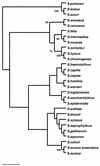rpoB gene sequence-based identification of Staphylococcus species
- PMID: 11923353
- PMCID: PMC140360
- DOI: 10.1128/JCM.40.4.1333-1338.2002
rpoB gene sequence-based identification of Staphylococcus species
Abstract
The complete sequence of rpoB, the gene encoding the beta subunit of RNA polymerase was determined for Staphylococcus saccharolyticus, Staphylococcus lugdunensis, S taphylococcus caprae, and Staphylococcus intermedius and partial sequences were obtained for an additional 27 Staphylococcus species. The complete rpoB sequences varied in length from 3,452 to 3,845 bp and had a 36.8 to 39.2% GC content. The partial sequences had 71.6 to 93.6% interspecies homology and exhibited a 0.08 to 0.8% intraspecific divergence. With a few exceptions, the phylogenetic relationships inferred from the partial rpoB sequences were in agreement with those previously derived from DNA-DNA hybridization studies and analyses of 16S ribosomal DNA gene sequences and partial HSP60 gene sequences. The staphylococcal rpoB sequence database we established enabled us to develop a molecular method for identifying Staphylococcus isolates by PCR followed by direct sequencing of the 751-bp amplicon. In blind tests, this method correctly identified 10 Staphylococcus isolates, and no positive results were obtained with 10 non-Staphylococcus gram-positive and gram-negative bacterial isolates. We propose partial sequencing of the rpoB gene as a new tool for the accurate identification of Staphylococcus isolates.
Figures

References
-
- Benito, M. J., M. M. Rodriguez, M. G. Cordoba, E. Aranda, and J. J. Cordoba. 2000. Rapid differentiation of Staphylococcus aureus from Staphylococcus spp. by arbitrarily primed-polymerase chain reaction. Lett. Appl. Microbiol. 31:368-373. - PubMed
-
- Bialkowska-Hobrzanska, H., H. V. Harry, D. Jaskot, and O. Hammerberg. 1990. Typing of coagulase-negative staphylococci by Southern hybridization of chromosomal DNA fingerprints using a ribosomal RNA probe. Eur. J. Microbiol. Infect. Dis. 9:588-594. - PubMed
-
- Birnbaum, D., M. Kelly, and A. W. Chow. 1991. Epidemiologic typing systems for coagulase-negative staphylococci. Infect. Control Hosp. Epidemiol. 12:319-326. - PubMed
Publication types
MeSH terms
Substances
LinkOut - more resources
Full Text Sources
Other Literature Sources
Molecular Biology Databases
Research Materials
Miscellaneous

